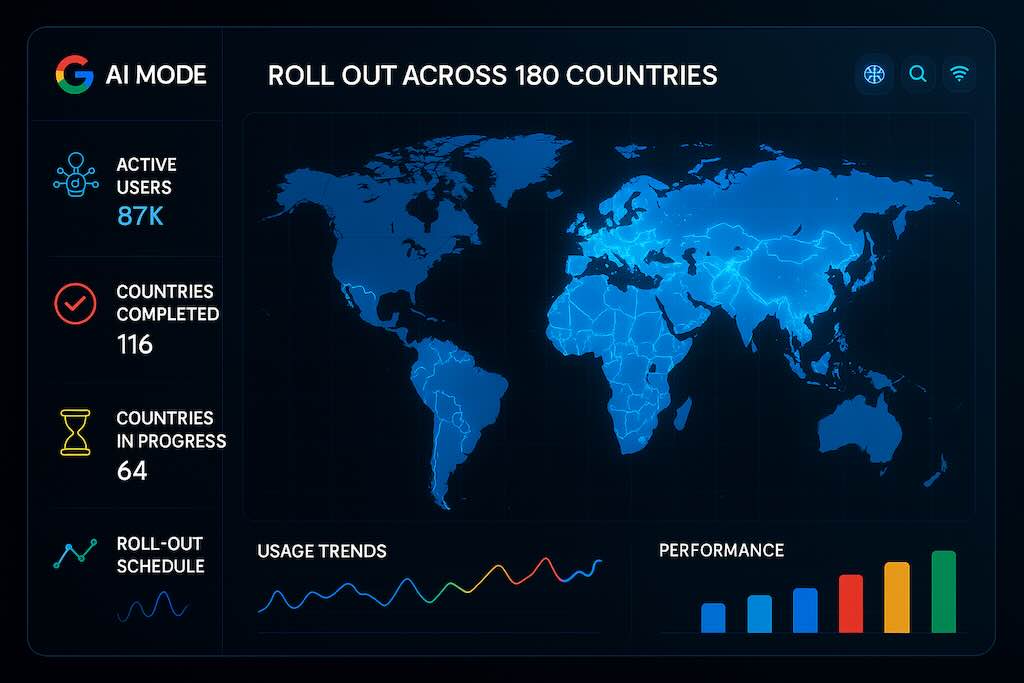Physical Address
304 North Cardinal St.
Dorchester Center, MA 02124
Physical Address
304 North Cardinal St.
Dorchester Center, MA 02124

Google has dramatically accelerated its AI Mode expansion to 180 countries and territories while simultaneously testing features designed to encourage clicks to websites, revealing the search giant’s attempt to balance AI-powered answers with publisher traffic concerns. The global rollout coincides with Google’s deployment of an updated AI model specifically improved for STEM queries, alongside new agentic features that enable more sophisticated user interactions and task completion.
The expansion represents Google’s most aggressive push toward AI-first search experiences, occurring amid heated debate about AI Overviews’ impact on website traffic. While Google’s Liz Reid maintains that clicks remain “relatively stable” and criticizes external studies as “flawed,” the company’s active testing of click encouragement features suggests internal recognition that AI-generated answers may indeed be reducing traditional website visits.
Google’s updated AI Mode model delivers enhanced performance for science, technology, engineering, and mathematics queries while introducing agentic capabilities that enable the system to complete multi-step tasks and provide more sophisticated assistance. The platform now includes compare checkboxes for products and local business listings, along with “People Also Search For” integration that maintains user engagement within Google’s ecosystem.
Testing has expanded to include AI Mode functionality in European Union markets, with Google experimenting with an “Ask Anything” box that leads directly to AI Mode conversations. Additional features under development include AI Overview explanations with overlay tests and knowledge panel integration that provides comprehensive information without requiring external website visits.
The rollout occurs against a backdrop of conflicting research about AI’s impact on website traffic, with Sparktoro research indicating that “traditional search is not declining” while Chartbeat data suggests traffic from Google to publishers has remained stable over recent years. However, a survey reveals that only 4% of searchers avoid clicking from Google AI Overviews, suggesting most users do interact with source content when provided.
Google’s testing of click encouragement features—including deep dive buttons, rounded search result snippet designs, and sticky search bars—demonstrates active experimentation with interface elements designed to drive traffic to external websites. These developments indicate Google’s awareness that publisher relationships remain critical for maintaining content quality and diversity within its search ecosystem.
The AI Mode expansion has coincided with significant technical challenges, including large crawling issues that impacted many websites for several weeks during the rollout period. Some sites experienced dramatic crawl rate declines in Google Search Console, while bugs affected the Performance Report search appearance for Android apps, highlighting the complexity of managing AI integration at global scale.
Google has also implemented preferred sources features in the US and UK, enabling high-quality publishers to achieve enhanced visibility in Top Stories results. This initiative suggests Google’s commitment to maintaining relationships with authoritative content creators while expanding AI-generated answer capabilities that could potentially reduce their traffic.
The 180-country AI Mode rollout represents Google’s most significant search interface transformation since the original launch of Google Search, with implications extending far beyond simple feature additions. The integration of agentic AI capabilities, enhanced STEM performance, and global accessibility positions Google AI Mode as a comprehensive information assistant rather than traditional search engine.
Google’s simultaneous testing of click encouragement features alongside AI expansion demonstrates the delicate balance between providing immediate user satisfaction through AI answers and maintaining the publisher ecosystem that provides the underlying content. The success of this balance will likely determine the future structure of web information discovery and digital content monetization models.